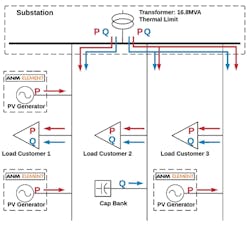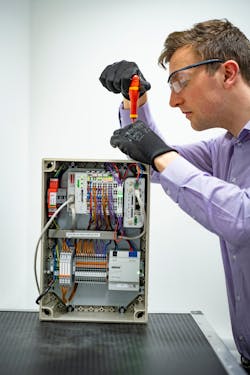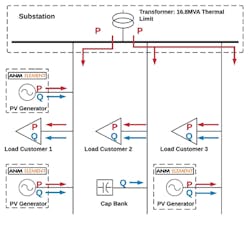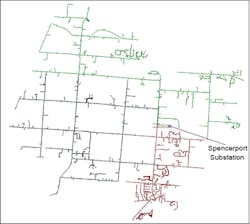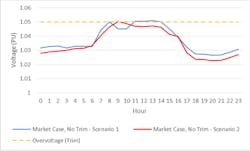The traditional grid has been reliable because it is centralized. When a customer flips a switch, the lights turn on. Originally, the grid was designed with large generators accounting for much of the electricity supply. Now, it is evolving to meet the needs of a clean energy economy and address the three key enabling trends of decentralization, decarbonization and digitalization.
As utilities look to integrate large quantities of renewable resources into the grid, balancing supply and demand in real time becomes more complex. Today’s electric grid must forecast demand in an increasingly shorter timescale. It also must provide control over a decreasing number of large generators and an increasing number of inverter-based resources (for example, photovoltaic solar, battery energy storage and wind). Each type of variable renewable generation has its own intermittent pattern of power production, influenced by local weather. This non-dispatchable nature combined with changing load patterns — driven by the decarbonization of transportation and heating — makes the management of today’s grid more complex.
Intelligent management of distributed energy resources (DERs) is key to grid efficiency. Smarter Grid Solutions and AVANGRID Inc. subsidiary Rochester Gas & Electric (RG&E) conducted a pilot project that simulated using reactive power dispatch from DERs to manage voltage and reactive power, with the goal of delivering power to customers in the most efficient way. The results from the project highlight the importance of studying the interactions between modern dynamic voltage management techniques and traditional static methods.
Interconnection Challenges
New localized challenges must be addressed when interconnecting DERs to the grid, including obtaining necessary utility approval. The amount of DER capacity that can be connected safely without significant system upgrades is dependent on the feeder line’s electrical characteristics. Another issue is the distribution network congestion immediately attached to DERs. As a result, voltage management can present localized challenges on distribution grids with heavy DER penetration.
At both the federal and state levels, there is interest in finding ways to aggregate and leverage DERs to solve grid-level issues as economically as possible. Viable solutions must fuse both technical and economic elements to enable a pragmatic and modern approach to managing the evolving grid.
From a technical perspective, if DERs are interconnected in ways that do not allow their output to be monitored and managed, costly grid modifications may be required to interconnect the DERs safely and reliably under various operating conditions. However, if DERs are managed intelligently, they can be interconnected to further enable their own proliferation without creating adverse impacts on the grid.
With the underlying ability for intelligently managed DERs to provide grid services, the focus then shifts to building DER participation models that can provide the right kind of incentives to unlock these services. From an economic perspective, the subsequent step focuses on new business models that can potentially expand a utility’s revenue streams and effectively turn challenges into opportunities. Together, this kind of techno-economic optimization of DER management can provide a framework for utility business models to evolve as new markets develop.
Higher levels of DER will result in a cleaner, more flexible but also more complex grid. For example, many modern DERs can be used to provide reactive power to loads and thus help to manage voltage and power flows on the grid. New business models to secure reactive power and voltage services from DERs can be part of the solution to help unlock that value.
Reactive Power Dispatch
Distribution grids traditionally solved localized feeder voltage management issues using a conventional and much less dynamic reactive power tool kit, typically including capacitor banks. For example, if a feeder were suffering from undervoltage issues, provisioning a shunt capacitor to statically provide reactive volt-amperes (VARs) would help with voltage support regardless of external conditions, either keeping it connected all the time or switching it in and out based on seasonal or daily schedules.
An increasingly dynamic and DER-heavy grid may require significant system upgrades to accommodate the safe, reliable interconnection of DERs. For example, say the same distribution feeder now has a significant penetration of photovoltaics (PV). During the day, the PV actively injects power into the middle of the feeder, causing a rise in local voltage. The existing fixed shunt capacitor exacerbates the problem by further boosting the voltage when not needed, potentially causing undesirable voltages. By evening, the PV power production drops and the voltage profile returns to the nominal arrangement, with voltage supported by the capacitor banks and any in-line voltage regulators.
When designed to do so, modern inverter-based DERs can vary their reactive power production, impacting voltage at the point of interconnection. If this function is enabled, DERs potentially can provide required reactive power as an alternative to installing distribution capacitor banks.
Reactive power dispatch works by dynamically identifying reactive power needs and then provisioning the need directly from local DERs as a grid service managed through a distributed energy resource management system (DERMS). Modern DERMS are real-time control platforms that enable monitoring and operational control of individual or aggregated DERs, and they typically link to existing utility operational systems. While DERs often are installed by third parties without an in-depth understanding of the grid’s operational needs and distributed generation impacts, DERMS have been developed to incorporate those considerations and provide utilities with a platform to manage diverse DERs intelligently and reliably on their grids.
With increased DER penetration, utilities will have to contend with voltage profiles that change drastically throughout the day. Using reactive power dispatch to deliver localized voltage support in addition to or as a replacement for conventional measures can enable DERs to provide grid services.
Simulation & Lab Results
Smarter Grid Solutions and AVANGRID Inc. subsidiary RG&E carried out a demonstration in New York that focused on distribution grid voltage management using reactive power dispatch. The aim was to simulate using reactive power dispatch from DERs to manage voltage and reactive power while delivering power to customers in the most efficient way.
The first simulation was carried out on RG&E’s Spencerport circuit, which already had 1.65 MVAR of fixed capacitor banks providing conventional voltage support by delivering constant reactive power; this maintained a substation target power factor of 0.97 as well as voltages within desired limits. When dynamic reactive power dispatch was added, the DERs were able to meet the local reactive power needs while maintaining voltage within levels, but this resulted in an additional 10.4 GVARh of total annual reactive power backfeed. These results highlight the importance of studying the interactions between modern dynamic voltage management techniques with traditional static methods.
In the second simulation, the fixed capacitor banks were removed from service to analyze the impact of relying solely on smart-managed DERs for reactive power support. In this instance, the DERs dynamically supported the grid while maintaining a power factor of 0.97 at the substation, effectively replacing the capacitors in the simulation, obviating their need and avoiding excessive reactive power backfeed.
With the removal of the capacitor and the inclusion of reactive power dispatch, the amount of reactive power supplied by the substation was minimized.
In addition to software-based time-series studies on the impacts of reactive power dispatch, a critical component of this project was the proof-of-concept implementation of fail-safe operational management of DER enabled by a modern DERMS. With the implementation of localized active network management (ANM) fail-safe logic, the DERMS stepped in to take interventional control actions during simulated overvoltages. While the average number of interventional control actions was reduced in a second scenario — without the capacitors oversupplying the system — the fail-safe control layer that steps in to prevent overvoltages was critical in both scenarios to ensure the system remained within nominal limits.
Projects like this showcase the best in innovation and agile collaboration within the clean energy sector and inform beneficial new approaches and business models that will help to propel utilities forward. The pilot demonstrated how suppliers and utilities can more efficiently manage the distribution grid of the future as well as how to optimize DER and grid operations in real time, a crucial element in supporting New York state’s energy and decarbonization goals for a clean, green future.
The pilot also established a framework that can illuminate paths for better managing an increasingly dynamic grid, a problem that has been punctuated by rapidly changing consumption profiles during the COVID-19 pandemic. Learnings from the demonstration could help shape the future grid to be more flexible and efficient in meeting changing profiles and trends of both supply (such as the growth of DER) and demand.
Scale The Solution
To scale this type of solution to a broader deployment, the next step is not only to continue to interconnect and accommodate DERs but to integrate their operations into the electric grid. Utilities can do this by leveraging a DERMS to manage their DER capabilities and deliver value to customers.
AVANGRID is exploring ways to deploy this technology and expand its use. DERMS is a key part of RG&E’s 2020 Distributed System Implementation Plan, which presents the company’s strategy to integrate DERs into the New York grid. Already, AVANGRID has begun to implement key features such as ANM and low-cost measurement, monitoring and control (MM&C) via demonstration and pilot projects in New York, in partnership with Smarter Grid Solutions and other technology providers. The lessons learned from these pilots will be applied to implement these technologies routinely starting in 2022, with the aim of implementing a fully capable DERMS system by 2025. Simultaneously, AVANGRID plans to do more proof-of-concept field trials with enabling technology.
However, the wider electric industry may face challenges when it comes to scaling innovative solutions, as even completing proof-of-concept field trials can require significant investments. Phased approaches to new solution development that decouple analytical stages with field trials and, finally, business-as-usual scaling tend to help illuminate a path of minimal regret.
Therefore, it is critical that opportunities to pivot solutions based on learnings throughout are built directly into the business-as-usual plan. Keeping an eye on business case development at every stage ensures the overall project is focused on customer value and the most pragmatic approach to scaling to deliver that value. Selecting the best technologies and overall design with scale in mind and keeping that focus on the end goal of replication at scale are crucial.
Flexible, Future-Proof Systems
Harnessing the power of DERs is one step toward helping to meet net-zero targets and greenhouse gas reduction goals. More attention is required to support smart, flexible DER-focused innovations by investigating and investing in capabilities that will lead to more flexible and resilient electric grids. Innovation will need to continue for the energy system to adapt to current trends and future needs.
The road map for DER management involves establishing a foundational fail-safe distribution platform that offers a visibility and management layer to the utility — so it can provide safe, reliable service — and then adding on a host of additional grid services that can realize a variety of DER participation models. Examples of this may include economic and market optimization for participation in wholesale markets, behind-the-meter and other forms of advanced utility-based optimization built on a suite of advanced technologies, tools, systems and analytics ruggedized for real-time operations.
This is a nascent and emerging field as the electric utility industry experiments with how best to accelerate the integration of DER and meet both policy and regulatory objectives. It is important to create the right kind of incentives that enable a flexible and resilient system. Both Smarter Grid Solutions and AVANGRID are working continuously toward these goals.
As a result of projects like reactive power dispatch, decentralized management of DER also can bolster the implementation of microgrids as alternative solutions for resiliency across AVANGRID service territories. Investments in DER management and microgrids can harden the grid and create a fast response to changes in electricity production and usage.
DERs, reactive power dispatch and then, later, more decentralized energy supplies and microgrids will all create an ecosystem of technologies that can help to fight against climate change by creating a sustainable, resilient and future-proof energy system that works in harmony for users in the U.S. and beyond.
Mark Jaggassar is director of grid analytics at Smarter Grid Solutions, where he focuses on how advanced analytics can be used in operational settings to optimally manage DER. He has developed and deployed advanced DER control strategies for both above and behind-the-meter resources with utilities in North America and the U.K. An active member of both the IEEE and the Institution of Engineering and Technology (IET), he received his bachelor’s degree in computer engineering from the University of Toronto, Canada, and master’s degree in sustainable electrical power from Brunel University, U.K.
Bob Manning is smart grids innovation and planning program director at AVANGRID Inc. and has been with the company for more than 30 years. Throughout his career, he has held various positions in the areas of grid modernization, distributed generation, operations, planning and reliability. He is a member of IEEE and a registered professional engineer in the state of Connecticut. He received his BSEE degree from Worcester Polytechnic Institute, Massachusetts, and MBA degree from the University of New Haven, Connecticut.

